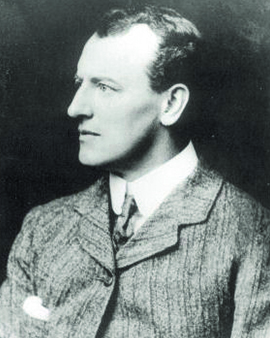After studying at several art schools in England, Sidney Paget drew for the British magazine The Strand. By far his best-known work came when he began designing the illustrations for the Sherlock Holmes stories. Sidney, whose older brother Walter was also an illustrator, only got this incredibly successful commission through a mix-up. The magazine actually wanted to send the order to his brother Walter, who was more successful at the time. Since they didn't know his first name, the letter ended up with Sidney. Rumor has it that Sidney designed the detective for it after Walter's likeness. Walter himself had always called these rumors made up. Whether modeled after his brother or not, Sidney drew a number of sketches after receiving the misdirected letter. When he took them to the publisher, these so convinced the publishers that they appointed Sidney as the illustrator of Sherlock Holmes - even though they had actually requested his brother. After Sidney's death, Walter Paget did work on the detective originally assigned to him. He illustrated the Sherlock Holmes story "The Dying Detective".
Even though Sidney only illustrated the first story by chance, he was personally requested by Sir Arthur Conan Doyle, the author of Sherlock Holmes, for all subsequent ones. For Sidney's pictures had a massive influence on Sherlock Holmes as we know him today. The checkered peaked cap, which nowadays can't be missing in any Holmes film, only came into being thanks to Paget's own fondness for this cap. Sir Doyle mentioned the cap only once as "an ear flapped traveling cap" in a story.
Paget kept his illustrations in black and white to emphasize the somber mood of the stories. The deep shadowy tone of his drawings thus gave Sir Doyle's texts an even grimmer sting. In this way, Sidney Paget probably also inspired many American detective films for their gritty setting. Most certainly he influenced every film version of Sherlock Holmes with it.
Sidney Paget's work was instrumental in shaping the shape and look of Sherlock Holmes and continues to influence it to this day. Sidney Paget himself appeared in ironic form in a Christmas special as a character creating the illustrations for Watson's Sherlock stories. In it, Mrs. Hudson criticizes his dark style, which would make her house dingy. Watson replies that the illustrator is out of his depth. He himself had grown a mustache so that readers would recognize him. In addition to Sherlock Holmes, Sidney Paget also breathed life into Arthur Morrison's detective Martin Hewitt with his drawings.
×





.jpg)
.jpg)
.jpg)
.jpg)
.jpg)
.jpg)
.jpg)
.jpg)
.jpg)
.jpg)
 published in Strand Magazine March 1893 (later colouration) - (MeisterDrucke-209358).jpg)
 published in Strand Magazine March 1893 (later colouration) - (MeisterDrucke-209358).jpg)
.jpg)
.jpg)
.jpg)
.jpg)
.jpg)
.jpg)
.jpg)
.jpg)
.jpg)
.jpg)
.jpg)
.jpg)
.jpg)
.jpg)
.jpg)
.jpg)
.jpg)
.jpg)
.jpg)
.jpg)
.jpg)
.jpg)
.jpg)
.jpg)
.jpg)
.jpg)
.jpg)
.jpg)
.jpg)
.jpg)
.jpg)
.jpg)
.jpg)
.jpg)
_illustration_from_British_Battles_on_-_(MeisterDrucke-389891).jpg)
_illustration_from_British_Battles_on_-_(MeisterDrucke-389891).jpg)
.jpg)
.jpg)
.jpg)
.jpg)
.jpg)
.jpg)
.jpg)
.jpg)
.jpg)
.jpg)
.jpg)
.jpg)
.jpg)
.jpg)
.jpg)
.jpg)
.jpg)
.jpg)
.jpg)
.jpg)
.jpg)
.jpg)
.jpg)
.jpg)
.jpg)
.jpg)
.jpg)
.jpg)
.jpg)
.jpg)
.jpg)
.jpg)
.jpg)
.jpg)
.jpg)
.jpg)
.jpg)
.jpg)
.jpg)
.jpg)
.jpg)
.jpg)
.jpg)
.jpg)
.jpg)
.jpg)
.jpg)
.jpg)
.jpg)
.jpg)
.jpg)
.jpg)
.jpg)
.jpg)
.jpg)
.jpg)
.jpg)
.jpg)
.jpg)
.jpg)
.jpg)
.jpg)
 Infantry marching into Camp at Souakim - (MeisterDrucke-174758).jpg)
 Infantry marching into Camp at Souakim - (MeisterDrucke-174758).jpg)
.jpg)
.jpg)
.jpg)
.jpg)
.jpg)
.jpg)
.jpg)
.jpg)
.jpg)
.jpg)
.jpg)
.jpg)
.jpg)
.jpg)
.jpg)
.jpg)
.jpg)
.jpg)
.jpg)
.jpg)
.jpg)
.jpg)
.jpg)
.jpg)
.jpg)
.jpg)
.jpg)
.jpg)
.jpg)
.jpg)
 - (MeisterDrucke-162345).jpg)
 - (MeisterDrucke-162345).jpg)
.jpg)
.jpg)
.jpg)
.jpg)
_-_(MeisterDrucke-1008761).jpg)
_-_(MeisterDrucke-1008761).jpg)
_-_(MeisterDrucke-1018457).jpg)
_-_(MeisterDrucke-1018457).jpg)
.jpg)
.jpg)
 taking Three Indian Spies Prisoners - (MeisterDrucke-185234).jpg)
 taking Three Indian Spies Prisoners - (MeisterDrucke-185234).jpg)
.jpg)
.jpg)
.jpg)
.jpg)
.jpg)
.jpg)
.jpg)
.jpg)
.jpg)
.jpg)
.jpg)
.jpg)
.jpg)
.jpg)
.jpg)
.jpg)
_-_(MeisterDrucke-989985).jpg)
_-_(MeisterDrucke-989985).jpg)
.jpg)
.jpg)
.jpg)
.jpg)
.jpg)
.jpg)
.jpg)
.jpg)
.jpg)
.jpg)
.jpg)
.jpg)
.jpg)
.jpg)
.jpg)
.jpg)
.jpg)
.jpg)
 published in Strand Magazine May 1893 - (MeisterDrucke-170677).jpg)
 published in Strand Magazine May 1893 - (MeisterDrucke-170677).jpg)
.jpg)
.jpg)
.jpg)
.jpg)
_-_(MeisterDrucke-964602).jpg)
_-_(MeisterDrucke-964602).jpg)






